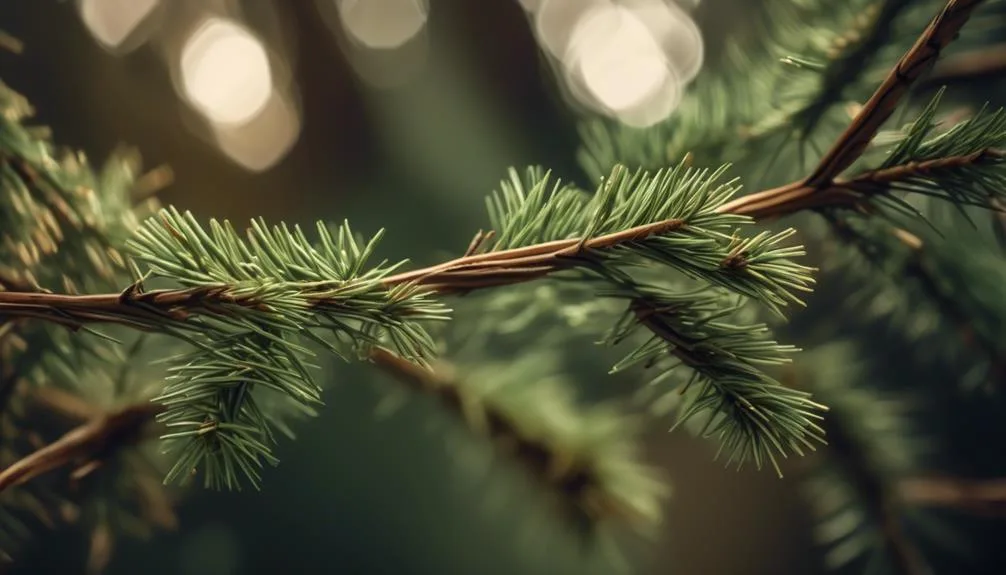Is your cedar tree's needles turning brown? It could be more than just a seasonal change.
Various factors like environmental stress, pests, and diseases could be causing distress. Understanding the root cause is crucial to finding the right solution.
Let's explore the common reasons for cedar tree needle browning and effective remedies.
Common Causes of Cedar Tree Needle Browning
If you notice brown needles on your cedar tree, the most common causes could be related to environmental stress, pests, or diseases.
One potential environmental stressor is soil pH. Cedar trees prefer acidic soil, so if the pH is too high, it can lead to nutrient deficiencies and needle browning.
Another factor to consider is water quality. Poor water quality, especially water high in salt content, can also cause the needles to turn brown.
It's essential to ensure your cedar tree is receiving the right balance of nutrients and water. Testing the soil pH and water quality can help pinpoint the issue and guide you in making the necessary adjustments to create a healthier environment for your cedar tree.
Identifying Environmental Stress Factors
To identify environmental stress factors affecting your cedar tree's health, carefully observe its surroundings and consider factors such as:
- Soil pH
- Water quality
- Potential pollutants in the area
Start by evaluating the soil moisture levels around the tree. Excessively dry or waterlogged soil can both lead to stress.
Also, take note of the sun exposure the tree receives. Cedar trees generally thrive in full sun but can suffer if they're suddenly exposed to intense sunlight or if their usual sunny environment becomes shaded.
Monitor any recent changes in the surroundings, such as construction work or new developments, which could introduce pollutants or disrupt the tree's natural environment.
Recognizing Pest Infestations
Pest infestations can significantly impact the health and vitality of your cedar tree, leading to visible signs of distress and potential long-term damage. Identifying pest infestations early is crucial for preventing further harm. Here are some signs to look out for:
- Yellowing or browning of needles: Discoloration on the needles is a common indicator of pest infestation.
- Presence of insects: Check for the presence of pests such as bagworms, spider mites, or cedar leaf miners on the tree.
- Unusual growths or spots on the tree: Abnormal growth patterns or spots on the bark can be a sign of pest activity.
- Premature needle drop: If the tree is shedding needles out of its regular cycle, it may be due to a pest infestation.
- Resin or sap production: Increased resin or sap on the tree can be a response to pest activity.
To prevent pest infestations, consider implementing integrated pest management strategies and regularly inspecting your cedar tree for any signs of trouble.
Understanding Cedar Tree Diseases
As you observe the health of your cedar tree, it's essential to also be aware of potential diseases that can affect its well-being, potentially linking to the signs of distress from pest infestations. Fungal infections are a common threat to cedar trees, manifesting as discolored or wilting foliage, and can lead to brown needles. Keep an eye out for signs of fungal growth on the branches or trunk.
Additionally, soil pH plays a crucial role in cedar tree health, as imbalanced pH levels can make the tree more susceptible to diseases. Ensuring the soil pH is within the optimal range for cedar trees can help prevent diseases. Regular soil testing and appropriate amendments can assist in maintaining the right pH levels for your cedar tree's well-being.
Remedies for Restoring Cedar Tree Health
Consider implementing these effective remedies to restore your cedar tree's health and vitality.
- Check Soil pH Levels: Test the soil to ensure it's slightly acidic, with a pH level between 6.0 and 6.5. Amend the soil with sulfur if it's too alkaline or add lime if it's too acidic to create the ideal environment for your cedar tree.
- Address Nutrient Deficiencies: Conduct a soil test to identify any nutrient deficiencies. Based on the results, apply a balanced fertilizer specifically formulated for cedar trees to replenish the lacking nutrients.
- Optimize Watering Techniques: Ensure proper drainage to prevent waterlogged soil, which can lead to root rot. Adjust your watering schedule to provide consistent moisture without overwatering.
- Install Irrigation Systems: Consider installing a drip irrigation system to deliver water directly to the roots, promoting efficient water usage and preventing foliage wetness that can attract pests and diseases.
Conclusion
In caring for your cedar tree, addressing environmental stress, pest infestations, and diseases is vital to its health.
By providing proper care, such as regular watering and pruning, you can help your cedar tree thrive.
With the right knowledge and attention, your cedar tree can continue to bring vibrancy to your yard for years to come.
Mark Hoffman is a dedicated arborist and tree care specialist with over a decade of experience. His love for trees began when he visited Yosemite National Park as a teenager and was awestruck by the giant sequoias. Mark pursued his passion by studying forestry at Michigan Technological University, where he earned a Bachelor of Science degree.
Since then, he has worked tirelessly in the field of arboriculture, helping to preserve and protect trees in his community. His expertise and dedication have made him a respected leader in the industry and a valuable resource for anyone seeking advice on tree care.
